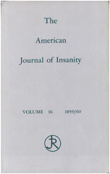Basal ganglia phosphorous metabolism in chronic schizophrenia
Abstract
OBJECTIVE: The authors examined whether there are abnormalities in high- energy phosphorous metabolism in the basal ganglia of schizophrenic patients. METHOD: In vivo 31P magnetic resonance spectroscopic imaging was performed on 18 chronic schizophrenic patients and 16 healthy comparison subjects. The percentages of total phosphorous signal for phosphomonoesters, inorganic phosphate, phosphodiesters, phosphocreatine, and beta-ATP were calculated. RESULTS: The mean percentages of beta-ATP signal in the right and left basal ganglia were significantly lower for the schizophrenic patients than for the comparison group. No other group differences in phosphorous metabolites and no lateral asymmetries in the schizophrenic group were noted. CONCLUSIONS: This preliminary study provides support for abnormal high- energy phosphorous metabolism in the basal ganglia of schizophrenic patients.
Access content
To read the fulltext, please use one of the options below to sign in or purchase access.- Personal login
- Institutional Login
- Sign in via OpenAthens
- Register for access
-
Please login/register if you wish to pair your device and check access availability.
Not a subscriber?
PsychiatryOnline subscription options offer access to the DSM-5 library, books, journals, CME, and patient resources. This all-in-one virtual library provides psychiatrists and mental health professionals with key resources for diagnosis, treatment, research, and professional development.
Need more help? PsychiatryOnline Customer Service may be reached by emailing [email protected] or by calling 800-368-5777 (in the U.S.) or 703-907-7322 (outside the U.S.).



